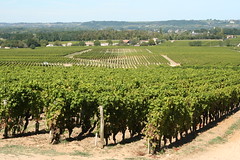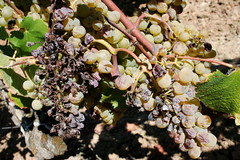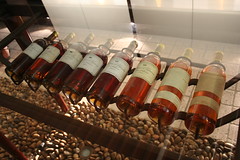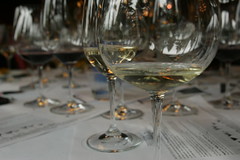 What is it about sweet wines getting such a bad rep? When offered a sweet wine, in my experience most people respond with a “No thanks. I don’t like sweet wines.”. Really? Are you sure about that, or are you basing that on the one cheap Asti you tried 15 years ago or the infamous Black Tower days of the 70s era? It’s kind of like the “I don’t drink white wine” syndrome that is purely based on the lesser, usually heavily-oaked Chardonnays we all had to choke down at weddings.
What is it about sweet wines getting such a bad rep? When offered a sweet wine, in my experience most people respond with a “No thanks. I don’t like sweet wines.”. Really? Are you sure about that, or are you basing that on the one cheap Asti you tried 15 years ago or the infamous Black Tower days of the 70s era? It’s kind of like the “I don’t drink white wine” syndrome that is purely based on the lesser, usually heavily-oaked Chardonnays we all had to choke down at weddings.
If you’re not drinking sweet wines, you are missing a big party in your mouth.
I recently took a few wine courses and tasted more than 30 wines at one go or over the course of a few hours – every kind of wine across the board. Reds, whites, cheap, expensive, sparkling, fortified, sweet… you name it, we tried it. It’s easy to swirl, swish, taste and spit when you’re on a mission. With a lot of wines to get through when you’re learning about this stuff, you want to spit and be sober at the end to know what end is up or down, for the most part. It’s the sweet wines that sneak by you, or rather, by your mouth. The “whoops, had to let that one slip down” wines – the mouth feel and taste on these guys are just so damn good you can’t spit them out.
So what is a sweet wine? Well, a few things. Firstly, a sweet wine is commonly referred to as dessert wine, simply because it’s nicely matched with, you guessed it, dessert. Sweet with sweet – a classic pairing. Sweet wines can be fortified, distilled, late harvest, Nobel Rot, enjoyed as an aperitif or with dessert.
I am hoping that laying out sweet wines in a bit of a mish-mash list might help to inspire you to hunt down and try some of these suggestions, starting with some fortified. Port is a perfect place to begin.
Port and Sherry are perhaps the better known fortified wines. Wines can also be made as dry and semi-dry, but my point here is to direct you to the excellence of the sweet ones. These can be strong and maybe even an acquired taste, but like all grape varietals and wines, you can always find one you like.
PORT:
Port is typically sweet, can only be called Port if it is produced in Portugal (in the Duoro Valley in the north) and is made by adding a neutral spirit such as Brandy to the fermentation process. Other countries make fortified wines in the port-style but cannot be called Port, such as Rutherglen Muscat, a dark-sweet syrupy wine from Victoria in Australia. You’re not going to find a specific varietal on a bottle of Port; they are made as a blend. Try these:
- Late Bottled Vintage (Noval Quinta do Noval)
- 10 Year Old Tawny (Graham’s)
- 20 Year Old Tawny (Taylor Fladgate)
- Vintage Port
SHERRY:
Like port, Sherry can only be called Sherry if it comes from a specific region. This time it’s Jerez, Spain, and like port it’s fortified with a grape spirit, but after fermentation. To most it is an acquired taste, but it’s so fine if you can get there. For the sickly sweet ones, look for Oloroso or PX on the label. It’s one of those things you just need to try it to believe it:
- Lustao Pedro Ximénez
- Sacromonte Oloroso
MADEIRA:
Very similar to port, this is a fortified wine but specifically made on the island of Madeira, off the coast of Portugal. Ranging from bone dry to luscious, these fine wines are most famous for their high refreshing acidity and their longevity, some able to last a 100 years+. The sweeter styles are sometimes labeled with the grape Malmsey or ‘Doce’, which means sweet. Next time, rather than a bottle of port, give Madeira a shot.
ICE WINE:
Frozen grapes on the vine typically only happens in cold climate countries, Canada and Germany being the most famous for their ice wines. The grapes used are often Riesling, Vidal, Cabernet Franc, Gewurtztraminer. Some Made In Canada picks:
- Henry of Pelham Cab Franc Ice Wine
- Inniskillin’s Vidal
- Tinhorn Creek
SPARKLING SWEETS:
A little sweet bubbly never goes astray. Your cheap and fresh recommendation is Moscato d’Asti. Try Cava dulce from Spain and of course there’s much to choose from in the Champagne aisle. Look for “Doux” on the label for the sweetest you can find.
 LATE-HARVEST:
LATE-HARVEST:
Saving the best until last. I love late harvest anything: Luscious and mouth-watering. Late harvest simply means the grapes were left on the vine longer than a typical harvest in the hopes of developing Nobel Rot, or “Botrytis Cinerea”. Yes, a thing called Nobel Rot is a very good thing when it comes to these grapes and wines. Some of my favourites and must-tries:
- Sauternes – from the Sauterne wine region in France, these wines are arguably the finest created (made from Semillon and Sauvignon Blanc grapes). Hunt down a Chateau d’Yquem. You’ll pay dearly, but it’s worth every cent.
- Tokaji from Hungary, a National Pride. Try Oremus Tokaji Aszu 3 Puttonyos.
- Late Harvest Riesling – Winery Schloss Johannisberg from the Rheingau is a good place to start.
- Late Harvest Sauvignon Blanc – look for the affordable Errazuriz Late Harvest from Chile.
- German Wines – check for Beerenauslese and Trockenbeerenauslese on the label – these are harder to find specialty items, age-worthy, and absolutely delectable.
 Best pairings for some of these luscious wines are some of the best foods that by no coincidence also melt in your mouth: cheese (stilton for Ports, soft cheese for ice wines), rich chocolate, nutty desserts with Sherry works well, or match up sweet or fruity desserts – and foie gras can definitely slip down with it all!
Best pairings for some of these luscious wines are some of the best foods that by no coincidence also melt in your mouth: cheese (stilton for Ports, soft cheese for ice wines), rich chocolate, nutty desserts with Sherry works well, or match up sweet or fruity desserts – and foie gras can definitely slip down with it all!
 We spent a day in the sub-region of Sauternes, home of the greatest sweet wines in the world. We were welcomed at Château Doisy-Védrines by the owner Olivier Casteja for a tour the property and a lunch in his modest, 2-storey farmhouse. Doisy-Védrines is situated in Barsac, within the Sauternes appellation, and has been owned by the Casteja family for generations.
We spent a day in the sub-region of Sauternes, home of the greatest sweet wines in the world. We were welcomed at Château Doisy-Védrines by the owner Olivier Casteja for a tour the property and a lunch in his modest, 2-storey farmhouse. Doisy-Védrines is situated in Barsac, within the Sauternes appellation, and has been owned by the Casteja family for generations.  Olivier toured us through the vineyards, explaining the process with which they make their sweet wines. He highlighted their low yields, the effects of Botrytis rot on the grapes and the arduous hand-harvesting procedure that spans for weeks to months; each step essential to the final product. Our 5-course lunch was paired with Doisy wines, with vintages dating back to 1970. It was fascinating to experience how well the sweet wines paired with each course.
Olivier toured us through the vineyards, explaining the process with which they make their sweet wines. He highlighted their low yields, the effects of Botrytis rot on the grapes and the arduous hand-harvesting procedure that spans for weeks to months; each step essential to the final product. Our 5-course lunch was paired with Doisy wines, with vintages dating back to 1970. It was fascinating to experience how well the sweet wines paired with each course. The iconic Château d’Yquem is considered to produce the finest dessert wine in the world. During this rare opportunity to tour the property, we learned about the laborious process of making this exceptional wine. Sauternes is produced by grapes which have been attacked by a fungus called Botrytis cinerea, also known as Noble Rot, that partially raisinates the grapes.
The iconic Château d’Yquem is considered to produce the finest dessert wine in the world. During this rare opportunity to tour the property, we learned about the laborious process of making this exceptional wine. Sauternes is produced by grapes which have been attacked by a fungus called Botrytis cinerea, also known as Noble Rot, that partially raisinates the grapes.  A unique combination of weather is required in order for noble rot to take form (cool misty mornings followed by warm dry afternoons) otherwise grey rot will develop, spoiling the grapes. Hand harvested one grape at a time over multiple passes through the vineyard (up to 14 for d’Yquem), the production of this wine is not only painstaking, but also a gamble with nature, as some years, when the conditions are not ideal, no wine is produced. The wines are reflectively expensive.
A unique combination of weather is required in order for noble rot to take form (cool misty mornings followed by warm dry afternoons) otherwise grey rot will develop, spoiling the grapes. Hand harvested one grape at a time over multiple passes through the vineyard (up to 14 for d’Yquem), the production of this wine is not only painstaking, but also a gamble with nature, as some years, when the conditions are not ideal, no wine is produced. The wines are reflectively expensive.  However a good Sauternes is an experience like no other for the senses. This nectar is deep gold in colour, lusciously sweet yet zesty and fresh, with rich tropical and earthy aromas and flavours that linger in your mouth for a very long time.
However a good Sauternes is an experience like no other for the senses. This nectar is deep gold in colour, lusciously sweet yet zesty and fresh, with rich tropical and earthy aromas and flavours that linger in your mouth for a very long time.


